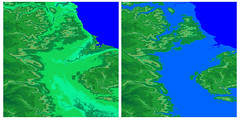
Image by pyrator via Flickr

News - December 5, 2007
Thunder, Hail, Fire: What Does Climate Change Mean for the U.S.?
The regional effects range from more wildfires in the west to stronger storms in the east.
By David Biello
The U.S. heartland can look forward to hotter, wetter summers, according to the latest climate research. Global warming will cause more severe thunderstorms—convective cloud fronts that could produce wind gusts of 58 miles (93 kilometers) per hour, 0.75-inch (1.9-centimeter) size hailstones and even more frequent tornadoes—in the region, according to research led by atmospheric scientist Robert Trapp at Purdue University. At the same time, according to independent environmental consultant Kristie Ebi, heat waves like the one in Chicago that killed 700 people in 1995 will become more commonplace.
"Climate change is projected to increase the frequency, intensity and duration of heat waves in the Midwest," says Ebi, an Intergovernmental Panel on Climate Change (IPCC) report author. "In addition, heat waves are projected to be hotter."
Of course, the U.S. Midwest is not the only region of the world that is being affected by climate change. Signs of global warming are beginning to appear everywhere: from runaway ice melt in the Arctic to slowly drowning islands in the Pacific. "Changing climate conditions are already happening," says Eileen Claussen, president of the Pew Center on Global Climate Change, which today released a report on regional impacts in the U.S. "It is clear that there is an immediate need for strong national and international policy action."
The reports findings, in addition to increased heat waves, include:
Western Wildfires—The increasingly destructive and widespread fire seasons of recent years are likely to continue due to a combination of increased drought and land development encroaching on naturally burning landscapes, along with a climate change–induced fuel boom (enhanced plant growth and a shift to more woody species) exacerbated by fire-suppression efforts leading to more abundant plant matter to fuel violent blazes, according to ecologist Dominique Bachelet of Oregon State University in Corvallis and The Nature Conservancy. "The deadly combination of human behavior and climate change means we will likely see more wildfires like those in 2007," she says.
Gulf Coast Swamped—Human engineering efforts such as levees have reduced the ability of the wetlands of Louisiana and other Gulf Coast states to keep pace with subsiding land and rising sea levels, according to coastal scientist Robert Twilley of Louisiana State University in Baton Rouge. "If soil formation cannot keep pace," he says, "inundation of wetlands from rising seas will essentially drown these landscapes, and wetlands will convert to open waters." That, in turn, will make nearby communities far more vulnerable to the effects of storm surges, such as the one caused by Hurricane Katrina in 2005.
"Dead Zones" Deader—One of a number of large and growing seasonal areas in bodies of water from which all oxygen has been leeched drives the degradation of Chesapeake Bay. A "dead zone" is a place devoid of the fish and bottom dwellers, such as the crabs and other shellfish, for which the bay is famous. Marine scientist Donald Boesch, president of the University of Maryland Center for Environmental Science, warns that climate change will also complicate the already difficult task of restoring this important watershed and food source. "Climate change impacts are not straightforward," he says, "but are multiple and interactive."
And the Pew report is not the only research to examine regional impacts.
Stronger Storms—Much of the country will experience severe thunderstorms, but major eastern and southeastern cities are likely to see the largest jumps in storm frequency, according to Purdue's Trapp—a finding buttressed by a NASA study earlier this year. "Our analysis suggests the possibility of an increase of up to 100 percent or more in locations such as Atlanta and New York," the researchers wrote in this week's Proceedings of the National Academy of Sciences.
As a result, these experts say efforts to combat climate change must focus not only on reducing greenhouse gas emissions that drive global warming but also on adjusting to the changes already underway. "The challenge we have with adaptation is trying to understand the specific impacts of climate change on a region," Boesch says. Nevertheless, "adaptation is going to be essential because we cannot avoid climate change entirely."
![Reblog this post [with Zemanta]](http://img.zemanta.com/reblog_e.png?x-id=8e75db0c-0389-4b3e-bb34-f8f92c02f915)